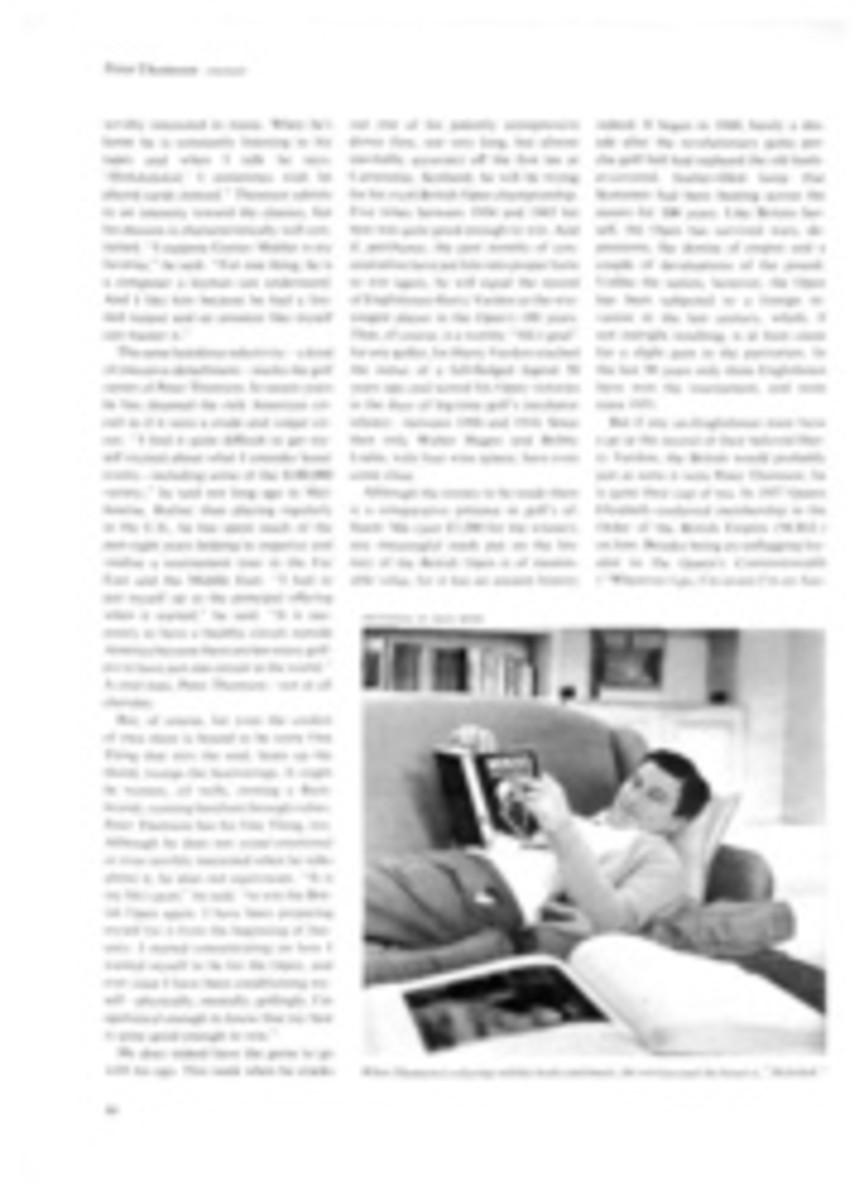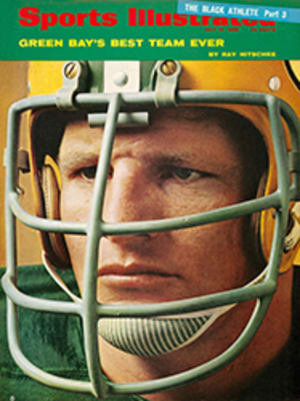
A one-fly angler who always travels light
In that immortal angling treatise, The Dry Fly & Fast Water, the late George M. L. La Branche describes the Alexandra, a silver-and-red English wet fly that represents "absolutely nothing in insect life (at least to the eye of man)." Yet, La Branche continues, "Its effect upon trout has been so deadly that it has been suggested by many English anglers that its use should be barred upon some streams."
Today, in the still-simon-pure world of angling for trout with a fly, there are some who would like to see another fly, the Rio Grande King, banned from all trout streams, especially when it is being fished by Richard J. O'Connor. A 52-year-old career bachelor and the regional manager of Sabena Airlines in Denver, O'Connor must be ranked as a superpurist among fly-fishermen, for when this happy Irishman approaches a trout stream, only his 7½-foot tonkin-cane rod and his well-worn hip boots show him to be a fisherman. He carries no creel or net, nor does he wear a fly vest stuffed with boxes of dries, wets, streamers, nymphs and all the other paraphernalia normally associated with fly-fishing for trout. Instead, O'Connor carries only one small Plexiglas box of Rio Grande King Hair Wings—fluffy, nondescript flies that do not resemble, or even imitate, anything in a trout's diet. But on the end of his wispy, 2.5-pound-test tapered leader, this no-account fly (O'Connor thinks it looks more like an "old reprobate, or maybe a miniature skunk," than anything else) has accounted for thousands of big trout in a wide range of waters throughout the world—Colorado's South Platte, the Test. England's famous chalk stream and the venerable Beaverkill in New York, to name but a few.
"I've had so much success with the Rio Grande King over the years that it's really embarrassing," O'Connor says. "I lay no claim to being a better fly-fisherman [he is, of course, an expert in the art]. I use the fly in size 10 or 12, which is fairly big, and fish it either wet or dry, but always with a floating line. It is not superior to any other pattern. It's really just a glump fly."
Actually, O'Connor uses a variation of the Rio Grande King with short hair wings (flytiers call it a trude fly). It is tied with a black chenille body, dark brown hackle, golden pheasant tail and tufts of white calf or deer hair for wings. "It is not a wild color pattern like the Parmachene Belle," says O'Connor, "or a match-the-hatch like the Ginger Quill or the Green Drake. But I like it because I can follow it easily in the water and I think that trout can see it better than a lot of other patterns."
The exact origin of the Rio Grande King is uncertain. One trout-fly historian says it is really a Black Coachman which someone "promiscuously" renamed the Rio Grande King. In the past two seasons, O'Connor has bought 76 dozen Rio Grande Kings from Dan Bailey, the flytier from Livingston, Mont., who makes up the hair-wing variation especially for O'Connor. Bailey thinks the fly may have originated in Colorado. "What I do know for certain," Bailey says, "is that it resembles nothing more than the fancy of the flytier and the fisherman. I have no idea why trout would fall for it, except that in O'Connor's case, it is being fished by a very skilled man." O'Connor first used the Rio Grande King on the Musconetcong River in Beatyestown, N.J. when be was 12. "I don't remember whether I found it in my dad's fly box or bought it at the local tackle store," he says. "But I caught trout on it, and I've used it everywhere since. Like on the chalk streams in England. I fished at least a dozen times on several of these waters during the war. It was rough fishing. You often have, as on the Test, a pure white-chalk bottom, and the trout there are terribly spooky. But the Rio Grande King produced just as well as the classic English patterns used by my hosts."
Then there was the day several years ago when O'Connor fished the Gunnison in Colorado during the willow-fly hatch. For three hours in the morning, he impaled live willow flies on a bare hook and caught a bunch of trout. For three hours in the afternoon he used the Rio Grande King and caught another bunch of trout. That evening in a café, he listened to other fishermen discussing the merits of willow-fly imitations turned out by various flytiers. "I was not about to put in my two cents' worth," O'Connor recalls. "I mean, there I was, fishing this old reprobate right in the middle of one of the most famous stone-fly hatches in the U.S.—and catching as many trout as everyone else."
O'Connor thinks this experience (and many others like it) proves a point about fishing mayfly hatches. "There is great satisfaction in the mystique of precisely matching the hatch and catching trout," he admits. "And who could begrudge the fisherman who gets a boot out of collecting hundreds of fly patterns, whether he catches fish on them or not. But I fish for big, hungry trout. So let's say there is a big hatch of black gnats—or green drakes, quill gordons or anything else—on the water. Now even with a perfect imitation, what chance do I have of catching a good fish when I'm competing with 20,000 of the real thing? A sizable trout sees all these bits and crumbs coming at him and then he sees a good-size hunk of meat—the old Rio Grande King. More often than not, he'll take the meat."
The very success he has enjoyed with the Rio Grande King has bugged O'Connor for a long time. So a few years ago he conducted several experiments. In one he filled a fish tank with water and put a mirror on the bottom, suspending two miner's headlamps, waterproofed with paraffin, in the tank to simulate the sun. Then he took some dry and wet flies—Rio Grande King, Grey Hackle, Grey Hackle Yellow, Royal Coachman and several other bright patterns—put them in the water and looked down in the mirror. "Now I'm not color blind," says O'Connor, "but all I saw were grays, blacks and variations of the two. The conditions, I figure, were roughly the same as they would be on a sunny day when a trout has strong light shining down into its eyes."
Suspecting that trout may be "color confused," O'Connor made another experiment. He bought tablecloths in red, orange, blue, yellow and white and tested the reactions of trout to them at a trout hatchery in Colorado. Mrs. Evelyn Seaman, wife of a fisheries biologist, wrapped a tablecloth around her shoulders—completely covering herself in front—and walked slowly down between the rows of trout tanks. O'Connor stood at the opposite end of the tanks, out of sight, and observed. "At both hatcheries," says O'Connor, "the only reactions from the trout came from red and orange. The fish immediately became uneasy, scurrying around and swimming away from Evelyn."
What do either of his experiments prove? "I haven't the faintest idea," O'Connor admits whimsically. "It may show that certain colors bring out certain reactions in trout. But I still don't know whether the attraction of the Rio Grande King to trout lies in its form or in its color, or both, or neither."
To be perfectly honest about the whole thing, the reason that the Rio Grande King attracts trout—at least for O'Connor—is that he is a master of the "precise presentation," which involves the accurate reading of a piece of trout water, the stealthy stalk (O'Connor often makes a crawling stalk, which explains why his hip boots are always worn through at the knees), the pinpoint cast and the feel for setting the hook at just the right instant. O'Connor has one more thing going for him, according to Cal Queal, the former outdoor editor of The Denver Post. "He talks to the fish," says Queal. "Sometimes soothingly, sometimes endearingly, sometimes with quiet but finely articulated profanity. I am not absolutely certain, but I suspect he intimidates fish...."
These days O'Connor does most of his intimidating of trout on two sections of leased water (17 miles of stream in all) located two hours by car from downtown Denver. To protect O'Connor from poachers (and me from O'Connor and the seven other Denverites who share the cost—about $365 a year per man—of fishing these trout-rich waters) it can only be said that 1) both leases are on the South Platte River, which winds through lovely Alpine-basin country in the Rocky Mountains, and that 2) both leases support wild and stocked strains of browns, rainbows and brookies.
The fishing is purely sensational. "We can afford to set our standards pretty high," O'Connor admits. "We allow only dry and wet flies, strictly for empirical reasons, and we think that to qualify as a fish, a trout must be at least 12 inches. This means that when one of us says he hooked and played 30 trout in a day—and that happens frequently—he has caught 30 trout over 12 inches, at least half of which are in the 2½-to-5 pound category, with maybe one or two even bigger. Of course, we are spoiled. It is not everywhere that a man can count on catching several trout a year well over five pounds and then put them back. At the risk of sounding maudlin, damn it, there is a special sense of pride in releasing a trout that big."
The biggest of the big trout, naturally, are not released. Thus it was on one of the leases, a narrow, 4½-mile stretch of water meandering through lush hay meadows, that O'Connor caught, on October 6, 1963, four brown trout weighing a total of 36 pounds 15 ounces—on the Rio Grande King. The biggest brown was a hook-jawed male that weighed 13 pounds five ounces.
"I saw the female first on a gravelly spawning bed," O'Connor recalls. "I made five casts before she spooked off. But I knew the old man had to be hiding nearby under the cutbank. So I started throwing the fly blind and letting it sink just under the surface as it drifted close by the cutbank. Suddenly there was an audible glub. I couldn't see the fly, but I set the hook anyway and he was on. The fight lasted 40 minutes and he took me straight downstream for a half mile. When I finally got my hand in his gills and dragged him up onto the bank, I reached into my shirt pocket for a cigarette. The whole pack was like putty. Then I felt water pouring out of my boots. I had been in up to my chest without realizing it."
It was not the biggest trout O'Connor has ever conned with the Rio Grande King. Several years before, on the same stretch of water, he hooked an unbelievable brown that he estimated at 18 to 20 pounds. But before O'Connor could collect himself, the trout had almost stripped his reel. As O'Connor tried to head the fish off, he tripped and fell in a boggy place. The leader parted a few seconds later.
O'Connor still insists that there is nothing supernatural about the Rio Grande King. "If there is a message here," he says, "it is that the old reprobate produces well for me because I fish more than the next guy. Furthermore, I don't fool around changing flies. I keep this one in the water all the time, and that's where you catch trout. There is one more thing. With apologies to all the match-the-hatch fanatics, a trout has a brain roughly the size of a pea. So how much can he really know?"
PHOTO
O'CONNOR WITH HIS 13-POUND BROWN

